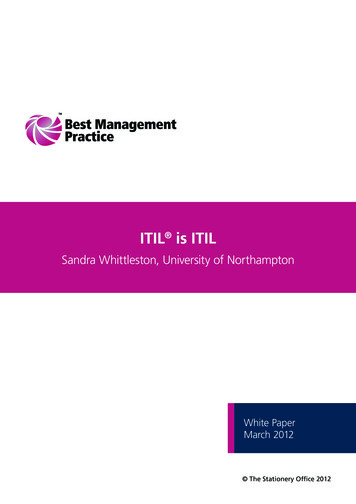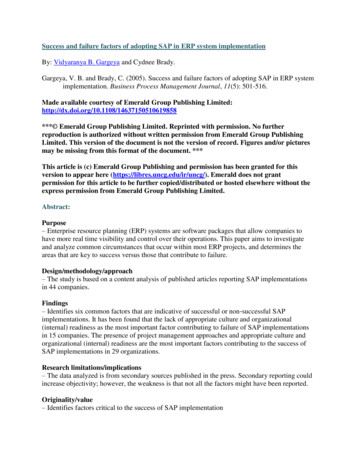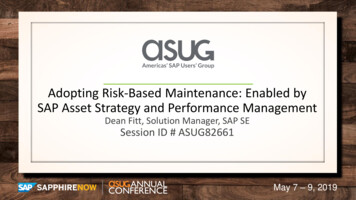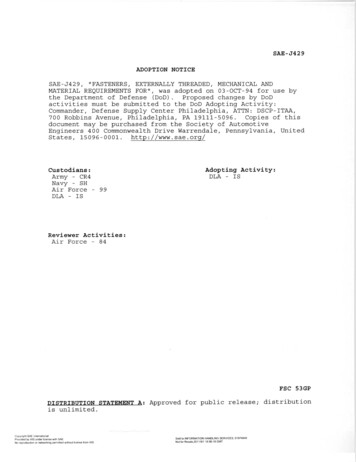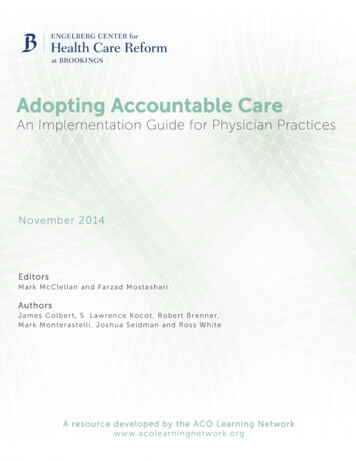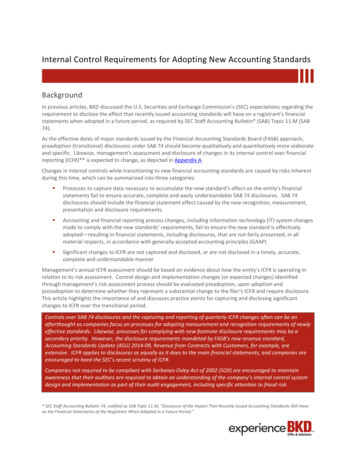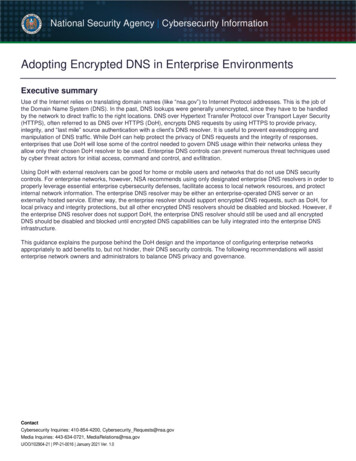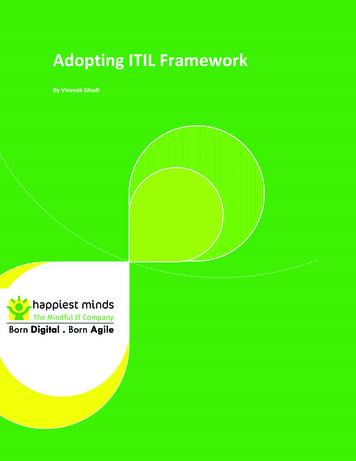
Transcription
Adopting ITIL FrameworkBy Vinayak Ghadi Happiest Minds Technologies Pvt. Ltd. All Rights Reserved
Adopting ITIL FrameworkContents1.Who should read this paper? . 32.Do we know about ITIL framework? . 33.Key Adoption Challenges . 64.How do we prepare ourselves? . 75.Basic Adoption Model . 96.Benefits of framework Adoption . 107.Solutions. 118.References . 119.About Happiest Minds . Error! Bookmark not defined. Happiest Minds Technologies. All Rights Reserved
In the chase between lion and deer .Many time deer wins .Because lion runs for food & deer for life.Remember; “Purpose is more important than need” 1. Who should read this paper?This white paper is targeted towards people and enterprises intending to adopt best practicesmodel for their IT Service management or people who are desperately striving to improvise theirservice model and want to drive their successes with proven methodologies in period to come.2. Do we know about ITIL framework?Information Technology Infrastructure Library (ITIL) is most popular framework for IT servicemanagement in fact for many businesses it is the basis for IT service improvement which talks aboutservice management as a practice and in detail about service lifecycle. Good practices are bestpractices which have gained wide acceptance and adoption. In short, Good Practices have withstoodthe test of time like ITIL.The core of ITIL The core of ITIL is structured around a Service Lifecycle which consists of the fivephases shown in the illustration below. The Service Lifecycle organizes activity around services asthe services move from concept through the live environment and into retirement or keepimprovising. The ITIL ‘core’ documentation consists of five volumes representing each of the phasesof the Service Lifecycle Happiest Minds Technologies. All Rights Reserved
Phases ofo Service lifeccycleAll these lifecyclelmodules go throuugh continual service imprrovement phaase to assure best plan, doo,check andd act cycle is in place and itt is practiced. Many proceesses are definned in each lifecycle whichhdescribes what has to be carried ouut in each lifeccycle phase.2.1 Servvice Strateegy: The Servvice strategy helps undersstand and proovides guidance on how toodesign, deevelop and immplement service managemment which wouldwhelp deefine policies,, guidelines andprocessess across the entire lifecyclee.For implementing ITIL framework foor any enterpprise service strategysproviides a visionaary platform totn based on its goals and vission which fulfills their visiion and puttinng that intoprepare service designble entities.measurab2.2 Servvice Desiggn: Guidance on design annd developmeent of servicees and interrelated servicemanagemment processees are definedd under this publication.pThis helps mappping strategic objectives intoportfolioss of service.Service deesign must seerve the visionn of the enterrprise into achievable and measurable servicearchitectuure catering needsnof those services and creating value to the business.2.3 Servvice Transsition: Guiddance on deveelopment andd improvement for capabilities andprocessess for transitioning new andd changed serrvices into opperation is covvered under thist phase,Realizatioon of service strategiessbeing mapped innto service deesign with control over risks of failure andaservice disruption is acchieved. Happiest Minds Technologies. All Rights Reserved
For putting a new Service Architecture into practice which aligns to the ITIL framework ServiceTransition would affect the services in operation and change management at most as it counts forrelatively good amount of risk and service disruption.2.4Service Operation:Effectiveness and efficiency of the service delivered and support to ensurethe value to the stakeholder depends upon the practices in the management of service operations.Service operation deals with proper delivery of services and its maintenance through various processeslike incident, problem, and Event management. It’s about keeping all the services in a healthy state anddelivering value to the service with agreed and achievable Service levels.2.5 Continual Service Improvement: This publication emphasizes on improvement ofprocesses in order to deliver value to the customers with better design and transition and measuringscope for continuous improvement.IT Service Management organizations can be structured as per the ITIL recommendations, whichdefines its scope based on four major functions (Service Desk, Technical Management, ApplicationManagement, and IT Operations Management).It also attributes its importance for standard roles to anytask and activity for good ITSM effort.Lifecycle PhaseService StrategyService DesignService TransitionService OperationProcessesService StrategyService Portfolio ManagementDemand ManagementFinancial ManagementService Catalogue ManagementService Level ManagementAvailability ManagementCapacity ManagementService Continuity ManagementIT Security ManagementSupplier ManagementChange ManagementService Asset and Configuration ManagementRelease and Deployment ManagementTransition Planning and SupportService Validation and TestingEvaluationKnowledge ManagementIncident ManagementProblem ManagementEvent Management Happiest Minds Technologies. All Rights Reserved
Service Request FulfilmentAccess ManagementContinual Service ImprovementThe Seven Step Improvement ProcessProcesses defined in each lifecycleProcesses listed above under all the lifecycles are important and they all are interrelated with theirmeasurable purposes, All processes are bind together with continual Service Improvement .ITIL stresseson improvising the available processes with best practices and with need.3. Key Adoption Challenges3.1.Understanding your own environmentMany enterprises wanting to adapt to best practices need to understand the requirement andimportance for it.They need to answer questions likeDo we really need ITIL? If yes how it is going to help us?What impact it will have on our in‐house processes which are in practice?Are we going to achieve detailed and measurable outcome?Can we map our enterprise vision into procedural roadmap to achieve it?Will that guarantee us ROI (Return on Investment)?Are we prepared to put RACI model in practice which emphasizes on Responsibility, Accountability,Consulting and Transparency in every function?After evaluating all those questions and assessing and analyzing the present infrastructure’s readinessone can opt for ITIL processes implementation into their environment.At Happiest Minds I have seen the efforts to make existing environment more cohesive for thestandard practices implementation, At IMSS department I have seen people being trained on ITIL andgetting them certified, Building NOC‐SOC facility aligning with standard practices, putting standardpolicies and practices in place, Defining SLA’s for internal IT service desk, Mapping organizations goalsinto practices of business unit with measurable outputs , Documenting all the processes and definingroles and responsibilities of all concerned , Evaluating the archived targets and planning forimprovements based on the evaluation results and feedback etc. Happiest Minds Technologies. All Rights Reserved
3.2.InterdependenciesITIL emphasizes more on People as they can be either service providers , service enablers or consumersof the service, Training people based on the role and requirements is the key for success.Processesanother important factor which has impact on success on any framework, Processes need tobe defined precisely aligning with business needs and should be measurable. Technologyis morekeyfactor which enables all the measurable to be more efficient and effective. Various tools and servicedelivery platforms play important role in service delivery and improvements of the same.ProcessPeopleTechnologyHence understanding these dependencies and making them more adaptive is the key for successfuladoption of the framework, yes we need to believe in rule: Adapt Improvise and Overcome. In otherwords it’s all about implementing new processes which would bring value to the business in long runand putting the processes in operation and trying to optimize the value to the business through cycle ofImplement, Operate, and Optimize.4. How do we prepare ourselves?We need to understand that it’s not about adopting the ITIL as a standard but improving the businesshence it’s all about using it with a level of resources and commitment to adopt.IT has to be seen asdeliverable service which can be optimized as per business demands. It needs business support from toplevel. Planning, measurement and improvement with existing infrastructure and striving forimprovement.Important factors like top level management support, Technology usage and availability, training of theresources will play lead role in preparation of the environment adaptable to the ITIL framework. Happiest Minds Technologies. All Rights Reserved
Crucial differentiators for ITIL Adoption4.1 Business Support: Top management support is one of the key elements in implementing anyproject, a detailed vision supporting your adaption of best practices as necessary funding is required fortraining, infrastructure build and tools availability.This has to be done with respect to the compliancepolicies and communication activities would be efficient with proper approval.4.2 Training & building knowledge database:Training all the stakeholders involved and makethem understand the ITIL processes and work together to for smoother implementation, Processeswould evolve with greater accuracy with proper cooperation .Proper documentation of every processwith understandable guidelines for each function and processes in turn create reliable knowledge baseover the period of time.4.3 Process Implementation and Technology:Initial analysis of the existing processes,implemented policies, impacting issues have to be analyzed.Prioritising the activities upon theircriticality and urgency and defining service levels and their dependencies has to be carried out.Supporting vendors their support framework impacts the implementation process. Monitoring theinfrastructure needs various tools as well service desks to make it happen.4.4 Change management:Adoption of any framework would result in major change on enterpriselevel as it is not just technology change but organizational culture acceptance and would influencechange management to a large extent.Change management practices in place would have to be reevaluated and make them effective enablersfor smooth transition of new or best processes which can bring in value to the business with lesserimpact and proper fallback plans in hand to avoid service disruption and discontinuity. Happiest Minds Technologies. All Rights Reserved
5. Basic Adoption ModelBasic adoption model for ITIL for any enterprise would start with building service strategy which helpanalyzing the existing infrastructure set up, reviewing policies in place, training people, documenting theprocesses and planning for the measurable targets aligned with enterprise vision.Service design ensures that defined objectives or vision under service strategy is actually mapped toservice portfolios. Managing the built processes and IT infrastructure with agreed service levels throughservice operation defined policies .Support and monitoring includes setting up service desk for allproblem, incident and change management to maintain service availability. Asset management helpedby configuration management helps tracking the resources.Basic Adoption ModelAbove figure describes the interrelated processes and function for basic ITIL adoption in a very simpleway stressing assessing and improvising the current processes and continuously planning forimprovements based upon feedback and necessary business requirements.Plan the service according to the business need which caters to the strategy and build the service withdefined processes with service levels helping to maintain the balance of disruptions, and then manage Happiest Minds Technologies. All Rights Reserved
those services with proper support and monitoring; keeping eye on improving the services with bettertools and changing business needs.6. Benefits of framework AdoptionThough ITIL’s goal is to provide structured and flexible guidelines for establishing governance standardsaround IT service management. It helps achieve higher user satisfaction, optimized resource utilization;helps understand and manage service levels, Improves ability to manage change, measurable usersatisfaction but few people find it more prescriptive ,too lengthy to implement ,needs training andrelatively slow return on investment .Few of the benefits are listed as below. Improved resource utilizationInfrastructure management becomes smoothProviding services meeting business, customer and user demandsUnified management tools, technology and peopleBest practices
This white paper is targeted towards people and enterprises intending to adopt best practices model for their IT Service management or people who are desperately striving to improvise their service model and want to drive their successes with proven methodologies in period to


